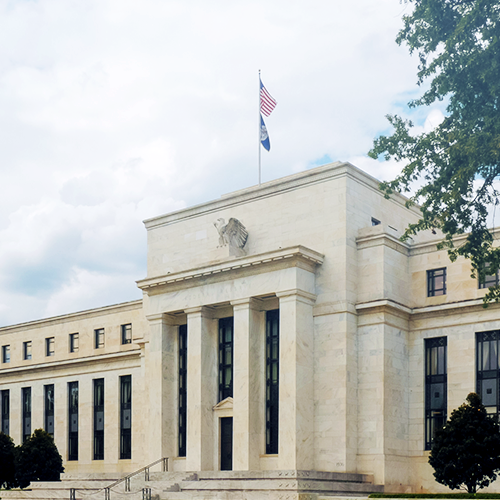
September 2024
The Rate Cuts Begin
The Fed lowers interest rates by a sizable 0.50%, stating inflation and employment goals are now “roughly in balance.”
Download PDFKey Takeaways
- As expected, the Federal Reserve’s Federal Open Market Committee (FOMC) at its September meeting cut interest rates by 0.50%. The federal funds target rate range now stands at 4.75% to 5.00%.
- The FOMC left the door open for two more 25-basis-point cuts in 2024, which would take the federal funds target range down to 4.25% to 4.50%.
- Fed officials said the continued lowering of inflation and desire to keep the job market from weaken further prompted the aggressive cut.
- The FOMC added language to its September statement by putting emphasis on the committee’s dual mandate (inflation and employment) and its focus on labor
market conditions.
At their September meeting, Federal Open Market Committee (FOMC) saw 11 of the 12 voting members agree to a 50-basis-point cut in the fed funds rate range to 4.75% to 5.00%, the first lowering of rates since 2020. The only dissenter wanted a 25-basis-point drop. The first interest-rate cut since the pandemic was expected, with the market predicting a 100% chance the fed would cut rates at this meeting. The only disagreement was whether the cut would be 25 or 50 basis points (market odds were 50-50). After the meeting, market expectations were for a 49% chance for another cut in November. The Fed’s dot plot also showed signs of more rate cuts ahead. Median dot-plot projections had the fed funds rate lowered to a range of 3.25% to 3.50% in 2025 (previously, it was 4.00% to 4.25%) and 2.75% to 3.00% by 2026 (down from 3.00% to 3.25%).
All of this seemed to be telegraphed by the Fed when it made a subtle revision to its policy statement at the July FOMC meeting. The committee emphasized being “attentive to the risks to both sides of its dual mandate,” a change from the previous focus on being “highly attentive to inflation risks.” Falling inflationary pressures so far in the second half of 2024 have also coincided with a softening labor market, a trend acknowledged in the July FOMC statement. While the labor market remains relatively healthy with low unemployment, monthly job gains have been modest, slowing and, for the most part, below expectations. Policymakers have increasingly cited this weakening labor market as one of the reasons for a looser monetary policy and this week’s 50-basis-point cut.
But beyond inflation and employment, other macroeconomic indicators such as manufacturing data and rising credit delinquencies have suggested a growing underlying weakness in the U.S. economy. Couple that with recent commentary by Fed officials about their inclination to move toward easier monetary policy, and the half-percent rate cut this month didn’t surprise many. The Fed’s most recent statement amplified the softer tone taken at the FOMC’s July meeting.

As for the committee’s economic projections for 2024 through 2026, there was virtually no change in real GDP or inflation, but unemployment expectations were revised higher and the fed funds rate significantly lower.

Below is the Fed's dot plot for September, which provides FOMC participants’ assessments of appropriate monetary policy by predicting the midpoint of target range or target level for the federal funds rate for 2024 and the following years.
Median Projections for Fed Funds Rates (2024-2027 and beyond)



In Conclusion
The sixth FOMC meeting of the year produced what market participants have long been waiting for—the first cut to the Fed’s benchmark rate since the pandemic. While the 50-basis-point lowering of rates seemed reasonable and did not offset the balance in the markets, growing sentiment among many FOMC members continues to center around balancing risks, especially labor-market data now that inflation looks to be on course to hit the Fed’s 2% target. Chair Jerome Powell’s comments at the post-meeting press conference confirmed that labor market conditions will continue to play a role in the FOMC’s decision on whether to cut rates further this year or to hold off on further cuts until 2025. “We’re trying to achieve a situation where we restore price stability without the kind of painful increase in unemployment that has come sometimes with disinflation,” he said.
Rate-cut expectations for the FOMC’s next meeting in November ended the day at 49%, according to the CME Groups Fedwatch Tool. While expectations from investors were for the FOMC to cut rates at this meeting, markets had priced in a coin flip as to whether it would be a 25- or 50-basis-point cut. But just as important was the committee’s economic projects for 2024, which gave markets a glimpse into the number and size of the cuts expected in 2024, 2025, and 2026. While the committee and Chair Powell delivered hints of possible paths for rates in their dot plot, we will have to wait and see if the committee’s dual-mandate focus will allow the Fed to cut rates further or maintain a higher-for-longer stance.
Definitions
One basis point is equal to 0.01%.
The Consumer Price Index (CPI) measures the overall change in consumer prices based on a representative basket of goods and services over time. Core CPI is the change in prices of goods and services, except for those from the food and energy sectors.
The Core Personal Consumption Expenditure (PCE) Price Index provides a measure of the prices paid by people for domestic purchases of goods and services, excluding the prices of food and energy. The core PCE is the Fed’s preferred inflation measure.
The federal funds rate is the target interest rate set by the Fed at which commercial banks borrow and lend their extra reserves to one another overnight.
The Dow Jones Industrial Average index (DJIA) tracks the share price of the top 30 large, publicly-owned U.S. companies which is often used as an indicator of the overall condition of the U.S. stock market.
Gross Domestic Product (GDP) is the total monetary or market value of all the finished goods and services produced within a country’s borders in a specific time period.
Loose or easy monetary policy is intended to stimulate the economy by making it cheaper for people and businesses to borrow money.
The S&P 500 Index is a market capitalization-weighted index of 500 widely held stocks often used as a proxy for the U.S. stock market.
The Summary of Economic Projections (SEP), known informally as the “dot plot,” is a collection of forecasts for the economy, inflation, the labor market, and interest rates offered by the seven Fed governors and 12 regional Fed presidents.
U.S. Treasury notes are debt securities issued by the U.S. and are loans made by the investor to the government with varying lengths of maturity.
Any performance data quoted represent past performance, which does not guarantee future results.
Index performance is not indicative of any fund’s performance. Indexes are unmanaged and it is not possible to invest directly in an index. For current standardized performance of the funds, please visit www.AristotleFunds.com.
The views expressed are as of the publication date and are presented for informational purposes only. These views should not be considered as investment advice, an endorsement of any security, mutual fund, sector or index, or to predict performance of any investment or market. Any forward-looking statements are not guaranteed. All material is compiled from sources believed to be reliable, but accuracy cannot be guaranteed. The opinions expressed herein are subject to change without notice as market and other conditions warrant.
Investors should consider a fund’s investment goal, risks, charges, and expenses carefully before investing. The prospectuses contain this and other information about the funds. The prospectuses and/or summary prospectuses should be read carefully before investing.
Investing involves risk. Principal loss is possible.
Foreside Financial Services, LLC, distributor.
Aristotle Investment Services LLC (AIS), a wholly owned subsidiary of Aristotle Capital Management, is the investment adviser to the Aristotle Funds. AIS also does business under the name Aristotle Pacific Capital and manages certain funds under that name.
Bloomberg Finance L.P. is unaffiliated with Aristotle Capital, Aristotle Funds, their affiliates, their distributors, and representatives.



